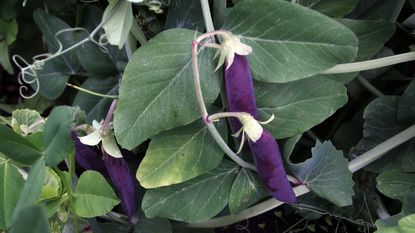History Of Blue Podded Blauwschokkers Garden Peas


If you're looking for a unique, heirloom pea that also has ornamental value, try blue podded blauwschokkers garden peas. The small, sweet smelling bicolored pea flowers, ranging from purple-blue to purple-white and pink-white, on this 5- to 6-foot tall vine are stunning in spring. The true beauty of blue podded blauwschokkers peas, though, comes when the flowers fade and become indigo blue pea pods - In fact, its name Blauwschokkers means "blue pod" in Dutch.
Blue Podded Pea History
Blue podded blauwschokkers peas (Pisum sativum) are an Old Dutch soup pea. In the cold winters of Northern Europe, gut-sticking, heavy meals like this were important. In Holland, one very popular heavy winter meal is a thick stew called Erwtensoep or Snert, which is usually made from pork, blue podded blauwschokkers peas, onions, carrots, leaks and potatoes. Blauwschokkers peas have been used in soups and stews in Holland and Germany since they were introduced by the Capuchin Monks in medieval times. They are sometimes called Capucijner peas because of this. Blue podded blauwschokkers garden peas were a staple food during times of famine in the Middle Ages.
Growing Blue Podded Blauwschokkers Peas
Hardy in zones 6-9, blauwschokkers peas are a cool season vine. They should be sown directly in the garden in early spring. They do not like to be moved once they have sprouted. Seeds should be planted 4-6 inches apart, with supports for them to climb, in sun to part shade. For best results, soak seeds overnight before planting. Many gardeners like to inoculate peas with rhizobium bacteria when planting to increase yields. Blue podded garden peas take 70-90 days to mature. They can be harvested when the pea pods are young and eaten fresh or used like snow peas. When allowed to fully mature, they can be shelled and used as soup peas. Mature, shelled peas should be soaked in water overnight before cooking. During the growing period, blauwschokkers peas are light feeders and will not require regular fertilization. Bees are attracted to the flowers and, according to some reports, blauwschokkers peas can cross pollinate with other garden peas.
Gardening tips, videos, info and more delivered right to your inbox!
Sign up for the Gardening Know How newsletter today and receive a free download of our most popular eBook "How to Grow Delicious Tomatoes."
-
 Want a Backyard Mini Orchard? Create Your Own Container Orchard
Want a Backyard Mini Orchard? Create Your Own Container OrchardEasier to care for in small spaces, a backyard mini-orchard makes sense for busy gardeners and juicy fruit is the reward.
By Teo Spengler
-
 Urban Beekeeping Guide: Top Tips For Raising Bees In The City
Urban Beekeeping Guide: Top Tips For Raising Bees In The CityUrban beekeeping can be a rewarding and appreciated pastime, but first be sure it’s legal in your city and learn the ropes of beekeeping.
By Mary Ellen Ellis